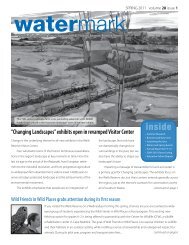Management Plan - National Estuarine Research Reserve System
Management Plan - National Estuarine Research Reserve System
Management Plan - National Estuarine Research Reserve System
You also want an ePaper? Increase the reach of your titles
YUMPU automatically turns print PDFs into web optimized ePapers that Google loves.
IX. Education and Outreach <strong>Plan</strong>Introduction◊The Wells <strong>National</strong> <strong>Estuarine</strong> <strong>Research</strong> <strong>Reserve</strong> isa regional center for education, training, and outreachon coastal, estuarine, and watershed ecology.<strong>Reserve</strong> education programs inform and engageaudiences in learning about coastal ecosystems,and how to manage them sustainably. Audiencesinclude thousands of regional residents and visitorsof all ages, as well as coastal management decisionmakers.Education programs translate researchinto readily available information and help promotestewardship of natural resources. They also providean information conduit between community decision-makersand <strong>Reserve</strong> researchers on sciencerelatedquestions and issues.Objectives and StrategiesObjective 1Design, implement, and support high-quality,science-based education programs that promotestewardship of the Gulf of Maine watershed andcoastal environments through understanding andappreciation of ecological systems and processes.Strategies◊ Complete a market analysis and needs assessmentto determine our niche in the K-12 environmentaleducation community.◊Expand the existing suite of coastal ecologyprograms for K-12 students in southern Maineand create qualitative evaluation methods forthese programs.◊◊◊◊◊◊Enhance docent training by developing aformalized training handbook and reviewingevaluation methods.Support citizen and student monitoring relatedto water quality, salt marsh restoration, invasivespecies, and endangered species.Develop public programs suitable for all agelevels.Expand access to the educational programs byincreasing handicap accessibility to programs,and implementing a formal outreach program.Develop and expand programs of joint interestto the <strong>Reserve</strong>’s <strong>Research</strong> and EducationDepartments.Develop programs that incorporate literature,the visual arts, and other artistic media.Enhance the educational content of the website.Objective 2Optimize educational use of the site and increasepublic awareness of its cultural and ecologicalsignificance.Strategies◊ Expand, improve, and promote the CoastalResource Library.◊◊Improve existing self-guided trail brochuresand create new materials.Enhance existing interpretive exhibits andprograms and develop new ones that focus onthe natural, cultural, and land use history ofthe site and south coastal Maine.◊◊Develop new trail and building signs thatinterpret the site’s natural history and thehistoric buildings.Make innovative use of the Forest LearningShelter, Teaching Laboratory, and other siteresources.Figure IX.1. An education staff person helps witha fish dissection.Objective 3Increase the use of science-based informationamong those who make decisions that affect coastalecosystems.68 Wells <strong>National</strong> <strong>Estuarine</strong> <strong>Research</strong> <strong>Reserve</strong>




